Did you know that more than 95% of new startups face significant business challenges, leading to their failure within five years of their creation? Welcome to the tough world of startups, where everyone knows the harsh realities and challenges businesses can face. Only the brave, and sometimes even the foolish, dare to start their own business.
But starting a traditional business is not without risks either. While it may seem less critical, it’s not entirely safe. According to the Bureau of Labor Statistics, only 25% of businesses survive more than 15 years. So, if you plan for the long run, the probability of failure is 75%.
Don’t be afraid, if your business has had depressing results quite recently. Fluctuations in revenue and website traffic are normal in this world. Just because things aren’t going well right now doesn’t mean your company will disappear from the business map. Ups and downs are part of the journey. Your business may be thriving this year, bringing on new employees, while next year may bring challenges that require layoffs to stay afloat.
Most of the time businesses can be rescued, even from the biggest swamp. By identifying problems early, implementing emergency plans and working hard, companies can rise from the ashes. When you save it, victory tastes sweeter than ever.
Are you ready to face the biggest challenges a business can encounter? This article won’t just present the challenges; It will also provide you with emergency strategies to help you navigate through them and avoid worst-case scenarios.
The biggest business challenges
In this chapter, we will sort out 10 of the biggest business challenges. We will write a few words about each of them, where we explain the whole scenario.
High add-to-cart, but low conversion
It means that you have visitors, who are very interested in your own product, but half a step before they actually buy the designated products, they leave your site. That’s what the experts call “shopping cart abandonment”.
What are the signs?
Your engagement rate is better than ever. You have the amount of visitors that are capable of buying enough products to reach your target numbers. The structure of your website looks good, and most of your customers find what they are looking for. Then where is the problem?
The first sign that something doesn’t work well is the less revenue compared to the last months. It can lead you to other questions, where do I lose interest? In this step, you can’t be sure that they leave your site one step before buying your products or services. You need to figure this out.
After you check your conversion funnels, you recognize an increased number of left visitors between the last two steps of at least one of your conversion funnels. Now, it is quite clear that the problem’s source is converting your potential buyers into buyers.
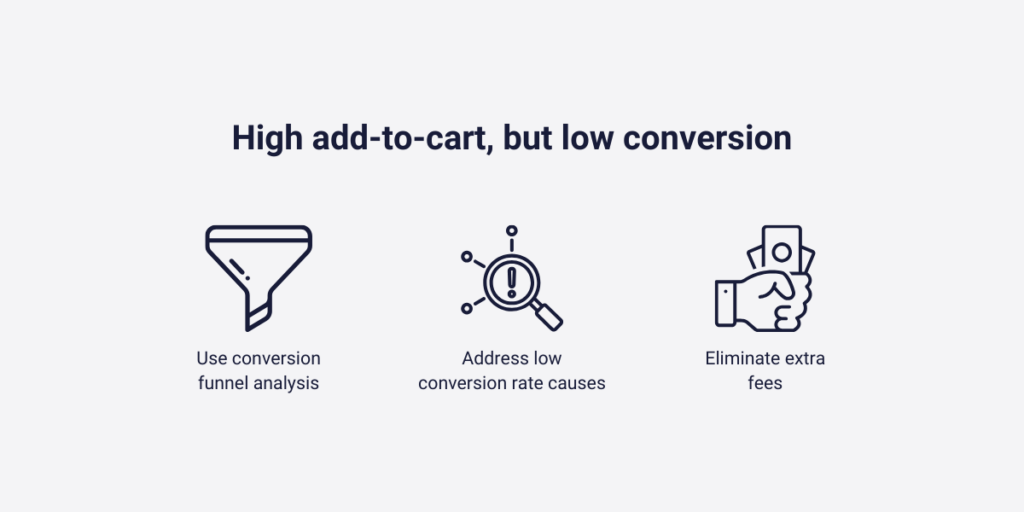
Solution
I mentioned that you need a conversion funnel analysis for proper understanding. Well, in general, you haven’t got this type of help from your website builder, also Google Analytics funnel analysis comes with huge limitations. You need to find an alternative, and that’s where Capturly Analytics can go in the picture. Our tool has a funnel analysis, with so many useful features. The possibility to create more than one funnel, the measurement of different phases drop-off rates, or an integrated session recording analysis; we offer you all of that.
But let’s move on to the solution. After you check that your conversion rate leaves much to be desired at the last step, you need to recognize the cause of this behavior. Maybe it comes from a missed feature, which would be important to many of your potential clients. It can be:
- You don’t have a mobile responsive design
- Your site does not save credit cards or personal information – the users are too lazy to type them again
It can also come from features you shouldn’t been introduced, since these slow down the whole procedure, just as:
- Creating an account right before the purchase
- Too many features, causing your site to be extra slow
If you introduce these tips, your customers are less likely to abandon your site, right before buying your products.
But the number one reason for cart abandonment belongs to none of the above groups. According to many researchers, adding extra fees to the total fee is the most frequent cause of this activity. This is the one that you must avoid at all costs!
High traffic, but low engagement
It means you have efficient channels to pour customers into your site, but they are uninterested in the products you sell, or just the whole business itself.
What are the signs?
The first sign in this case is when you divide your buyers (who actually bought something from your webshop) by your visitors (who somehow reached your site). A good buyer/visitor (multiplying with 100) conversion rate is 2% to 5%, but be aware it all depends on the industry in which your company is working. For example, this number is relatively lower in the luxury industries, but if you sell items for higher profit margins, you can let this happen.
If your conversion rate is less than 1%, you still don’t have to worry, but it can be a sign of low engagement. After you check this, you need to check your heatmap statistics with Capturly Analytics. If you analyze your scroll heatmaps, and you realize that most of your customers don’t scroll too much, it’s another good sign for low engagement. If your click heatmaps also show relatively small activity, you can be sure that you can’t engage with your visitors well.

Solution
Luckily, there are some great ways to increase your engagement scores. Most of the time you need to give more value to your customers and understand to them that browsing on your site is not a time-wasting activity, instead they can learn many useful things. Useful things that will bring them advantages over their competitors.
It can be:
- Quality blog articles, with many useful information
- Creating, and sharing user-generated content
- Implementing chatbots to let them ask their questions
- Create a better navigation system on your site
High lead generation, and low sales
Here, you can convince your potential buyers to buy your products, but something happens on your site, which makes them change their minds.
What are the signs?
In this case, the first sign can be very similar to the last one. You have a good number of visitors, and your leads’ click through rates are quite high, but you still can’t sell the right amount of products.
The real sign, where you can be sure that you are suffering from this problem, is when there is a difference between those customers selling rate numbers, who are not coming from your leads, and those who reached your site via your leads. So those visitors, who see one of your advertisements, are less likely to buy from you than the others.
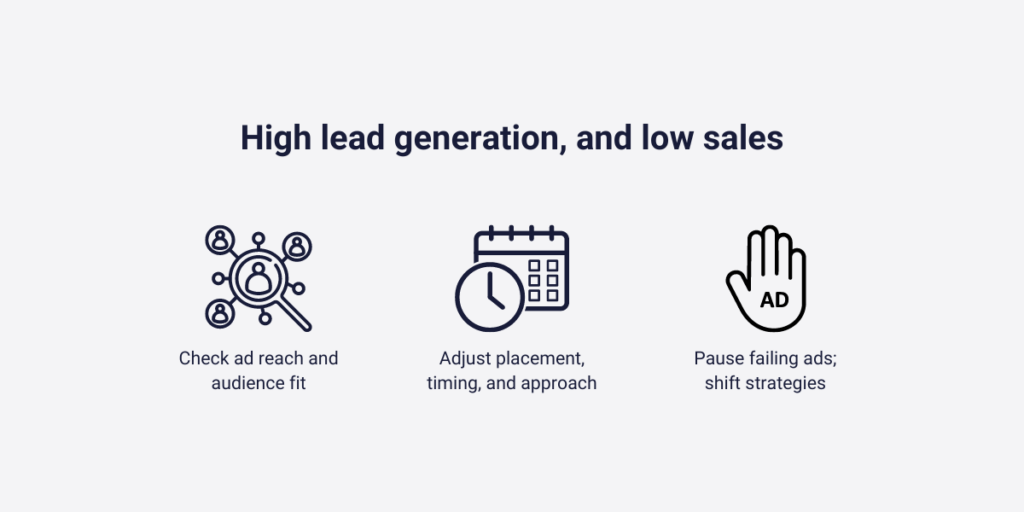
Solution
Most of the time the real problem is that you reach those people with your leads, who are not taking a place in any of your target groups. So you didn’t specifically think of these people to buy your products when you established the company or the website.
They are not from the right demographics, or they haven’t got any interest in your products. Here, the solution is quite simple but takes some money. You need to rethink where, what time, which way are you advertising, and whether these are corresponding with your target audiences. If not, you need to pause it and focus on other marketing strategies, elsewhere.
High sign-ups, but low email open rate
This time you can convince your customers to sign up for your email newsletter, but you can’t deliver the email to them, or they can not open these emails.
What are the signs?
Detecting this issue is quite simple. You have a high number of sign-ups, but just a few of these customers really open your delivered emails.
A normal email open rate also differs from the industries you are participating in, but the average, according to Campaignmonitor, is around 17% to 28%. If your numbers are a little smaller than these, you don’t need to be thinking about bad emails. Also, if you have zero, or very low email open rates, I don’t think that the problem comes from your badly structured, awful-looking emails. Maybe the given email addresses no longer exist, or you make typos in most of them.

Solution
And even if the problem comes from the quality of your emails, I have some good news for you. These are easily manageable, and you can go back on track by just implementing a few simple tricks.
For example:
- Your subject line is irrelevant – create more engaging subject lines with AI
- You send the same emails to everyone – create different segments, and tailor your emails based on these segments’ needs
- Using inappropriate, or aggressive words – test your emails efficiency even before delivering them to your customers
High page views, but low time on site
Here, you may have discovered methods to attract attention to your site, but visitors aren’t as committed to spending the anticipated amount of time there.
What are the signs?
The first sign is very similar to a few of the mentioned ones. Less revenue, worse conversion rates. Then you need to analyze it more deeply to be sure that this is your site’s problem. Enable and track with Capturly’s click and scroll heatmaps, where you detect fewer clicks and scrolls than in the last couple of months. After you are done with this, you need to take one more step to be sure that the problem is the low time your customers spend on your site. You need to watch individual sessions and track their lengths.
According to Websitebuilderexpert statistics, the average time a visitor spends on a webpage depends on two things:
- The industry that you are participating in – E-commerce websites experience faster sessions, as most of the customers want quick buying procedures.
- The type of the opened webpage – it is essential to know what kind of webpage we are talking about; customers will spend more time on a blog article, than on a landing page.
If your detected numbers correspond with the industrial data or the exact type of webpage’s data, you can be sure that your problem is something else. However, if you experience a difference between your numbers and found data, you can be sure that your visitors spend relatively little time on your site.
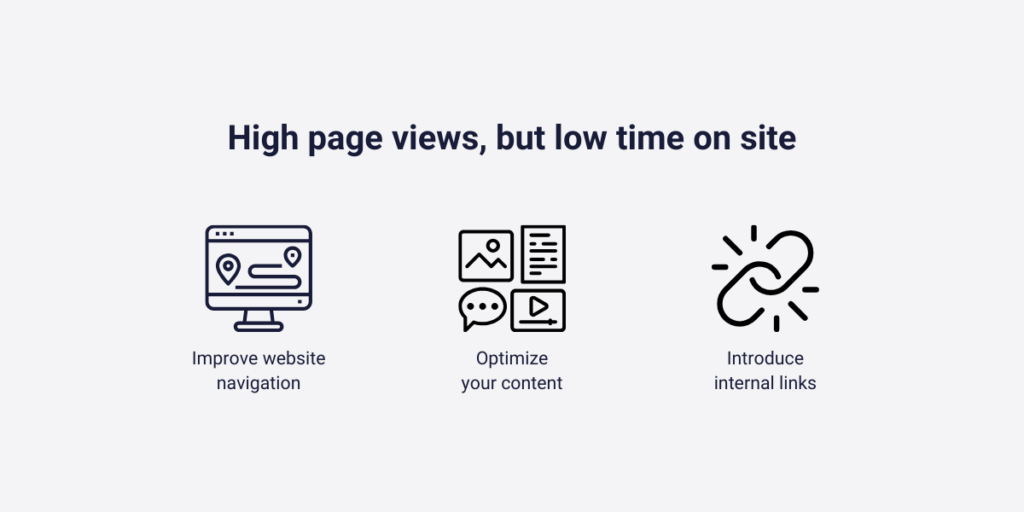
Solution
It is a very complex problem, and it’s very hard to decide what to do. There are different tactics to convince your potential buyers to spend more time on your site, but none of them ensure a 100% positive change. However, these possible changes not only help you convince your visitors to stay longer, but they can generate other positive factors for your company.
These are the possible solutions:
- Create a more efficient navigation system – Sometimes your customers don’t spend too much time on your site since it takes too much time to reach from one specific area to another. It can be because of overloaded elements, slow load time, or unreadable fonts.
- Optimize your content – Make your content colorful, and simple, and highlight the most important keywords. Customers usually don’t read long, and complex articles. They usually just scan and look for the most important information which can help them to get out of trouble.
- Introduce internal links – Your users most of the time reach your page to specifically go for a designated place, but as in brick-and-mortar shops, you can convince them to read your other content (or buy more products). Internal links are great, as they can distract your customers for their main purpose to spend more time on your site.
In this part, there are a tremendous amount of possible solutions, so if these aren’t working, but you are sure that you have this type of problem, look for other possible solutions, and implement those.
High mobile traffic, but low mobile conversion
In this case, you find ways to connect mobile users with your site, but they leave your site very quickly. Even before they reach your projected goals.
What are the signs?
First, you have the old but gold recognition: one of your goals has less conversion than it was in the last couple of months. However, you don’t understand as some of your customers still go smoothly down your conversion funnels, but not all. This is the moment, where you need to think about, and better start to use Capturly’s heatmap and conversion funnel functions. Both of our tools have filtering options, which is the savior this time. Here, you can filter mobile traffic, and analyze the data without distracting desktop, and tablet users.
After you check these, you can go to the conversion funnel function which is in a complete bond with both our heatmap and session recording functions. If you detect a difference between desktop and mobile conversions, but not the quantity of the traffic itself compared to the last months, and the desktop seems to have the normal value, you get to know your issue.
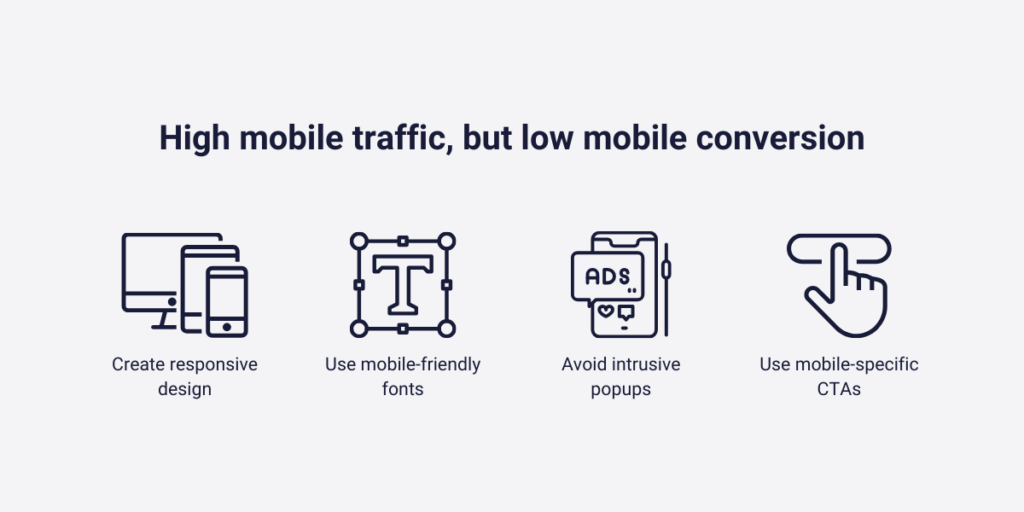
Solution
When mobile conversions differ from desktop conversions, you can almost be sure that your issues are only mobile specifics. At this time, you better not touch those functions that affect all of your clients, just change those that only affect mobile users.
These can be:
- Introducing a mobile responsive design on your website
- Use mobile-friendly fonts
- Do not distract their screen with pop-ups
- Use mobile-specific call-to-actions
These will all help you to engage your mobile users a little more.
High sign-up rates, and low user activity
This issue is one of the most common business challenges, it suggests that while customers happily click on your website’s CTAs (call-to-actions), register, or create accounts, they don’t appear engaged beyond those actions.
What are the signs?
One of the easiest ones to detect. Generally, fewer users use your site frequently. On Capturly, you can check this at the “dashboard” menu bar. If you have fewer sessions and page views, than the last couple of months, you experience lower user activity. Now, you need to also check that based on your sign-up rates, how many percent of your visitors would be considered “active users”, and compared to that number, how many percent you have. If your number is lower than the average, or based on last year’s data, you have lower user activity, but your sign-up rates are high, you face this challenge.
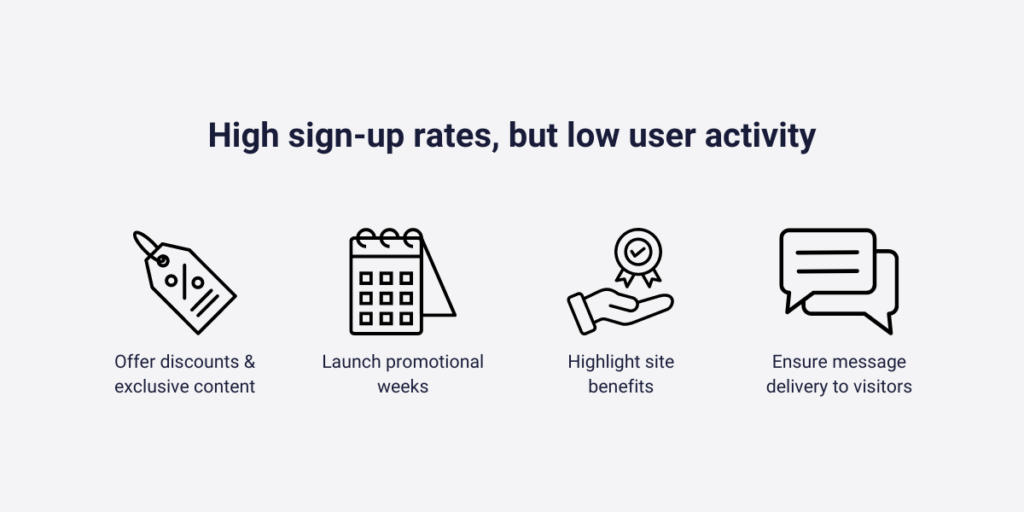
Solution
Your visitors are not too loyal in this case. Maybe they purchased from you one time, but that was just a temporary sympathy.
Your main focus here is to somehow convince them to look out for your site again. The best advice is to offer them discounts, exclusive content, or introduce promotional weeks. Also, try to demonstrate the benefits of using your site, and ensure that they get these messages.
High product views, but low wishlist adds
Here, your potential buyers like your products, but there’s one, or more concerning factors which lead them to change their mind about a possible purchase.
What are the signs?
This challenge is also very easily trackable. You have the overall number of clicks to each of your products, and that’s also the case with wishlists. The main problem is that there is no exact research on the connection between product views and “wishlist adds”. So, for example, we don’t know that if you have 100 product views, what percentage of “wishlist adds” is a great number amongst them? Outside that, it is not that hard to sense that something doesn’t work well.
On Capturly Analytics you need to create two conversion funnels to detect whether you struggle with this challenge, or not. After you create both funnels, one converts after the user clicks to see your products, and one converts if they added your products to the wishlist. If you detect a very big gap between the two numbers, after gathering data for at least a week, you need to find solutions to this issue.
Solutions
There can be several reasons why you don’t have enough “wishlist adds”. Here are a few tips, that we have faced throughout our history:
- Your users don’t find the “add to wishlist” button – highlight this button even more, and emphasize its advantages
- This activity is complex, or inconvenient – adding items to the wishlist may be a good deal, unlike in that case when it brings you to another page, and navigating back to the original takes too much time. Make these routes more clear, and ensure that clicking the “add to wishlist” button doesn’t move the users elsewhere.
There are some other tips as well, if none of these help you, bravely look for others!
High checkout starts, but low finishes
Partly the same with the first issue. In this case, the customers not only add their favorite products to the cart, but they also start the checkout process. However, for some reason, they don’t end it.
What are the signs?
Since it is very similar to the first challenge, I wouldn’t mind spending fewer words on it. In this case, even when you are satisfied with your site’s number of visitors, they have yet to buy those products that they are interested in. They still reach the checkout stage, so you spoil something after that.
These are all easily detected, if you follow only one rule: use one of the available analytics tool’s plans. Like Capturly Analytics plans. If you set your funnel in our software correctly, you can easily detect that you lose your users directly at the finish stage. If this number is relatively bigger than the actual industrial data, you need to listen to me wisely right now.
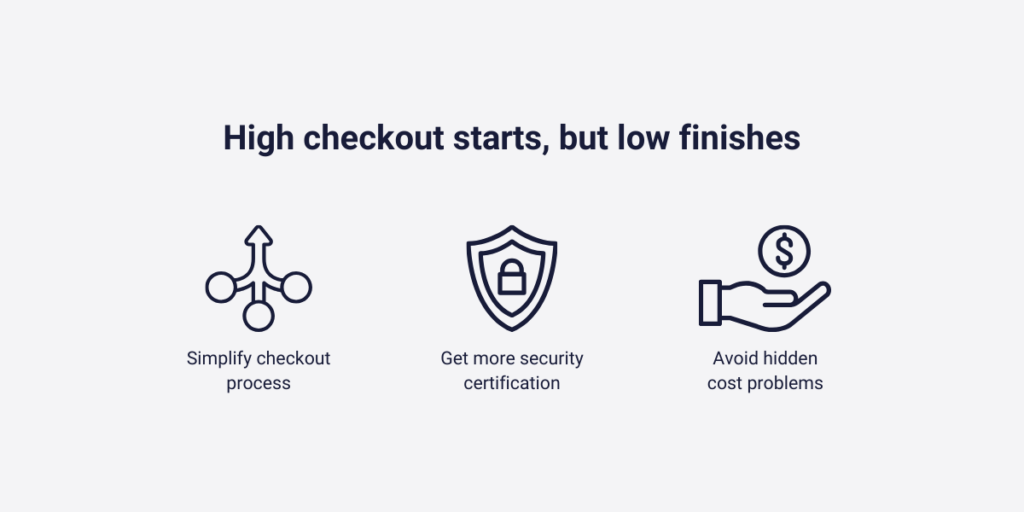
Solution
You need to ask yourself the question: what are my potential buyer’s problems with the website’s checkout process?
- Is it too complicated? – Make it more simple!
- Isn’t it secure enough? – Get more security certification!
- Do you have hidden costs that you reveal in the end? – Delete all of these, and emphasize way earlier what they can expect.
Once I highlighted before that according to researchers, the third one makes the buyers the most frustrated. Avoid at any cost!
High new visitors, but low repeat visitors
You have a great number of first-time visitors, but you can’t convince them of a possible repurchase later on.
What are the signs?
This challenge is very similar to the consequence of low user activity. Although, low user activity, but a high sign-up rate doesn’t always mean that you have no clue how to engage your buyers for more purchases (but that’s the general conclusion, so my advice is also connected to this problem there), in this challenge the problem is definitely the ignorance of low repeat visitors.
Due to Capturly’s very effective filtering options, you can easily sort out the number of new and repeat visitors. According to your webpage duration, and phase I can’t give you exact numbers about a great new visitors/repeat visitors ratio. You need to figure out your normal ratio from your previous data and analyze whether it is acceptable, or not. If it’s not, and it’s because of the low number of repeat visitors, you must do the following:
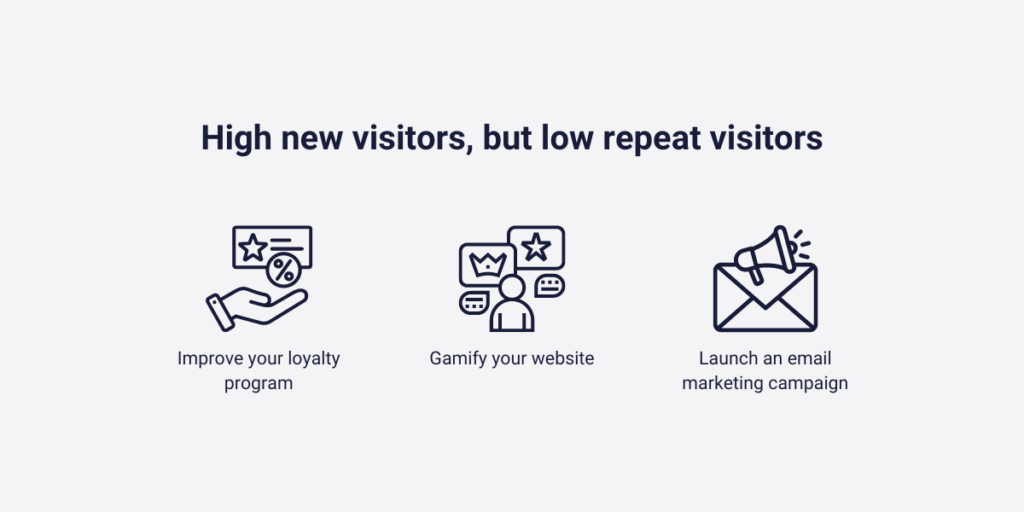
Solution
The solution is quite similar to what I offered to you on the “high sign-up rate, but low user activity” part. In this case, your visitors are uninterested in buying from you once again, so you must convince them with:
- Offering discounts, incentives, and other exclusive content. You need to make advertisements of these acts, and somehow carry these messages to them.
- Create interactive features, which are fun to play, or fun to make, to enhance better user experience.
- Launch an email marketing campaign, since maybe they just need a quick reminder to shop from you once again.
Conclusion
In this article, we’ve explored 10 distinct business challenges and numerous effective strategies to help you overcome tough times. Remember, in the business world, fortunes can change rapidly. Even if your company seems invincible one day, it could face its demise the next.
The success of your company often hinges on one critical factor: how you manage crises. Crises don’t resolve themselves without human intervention. You must think quickly, identify the real obstacles, and address them promptly to minimize their impact. Whatever approach you take, speed is of the essence!
Don't forget, sharing is caring! :)

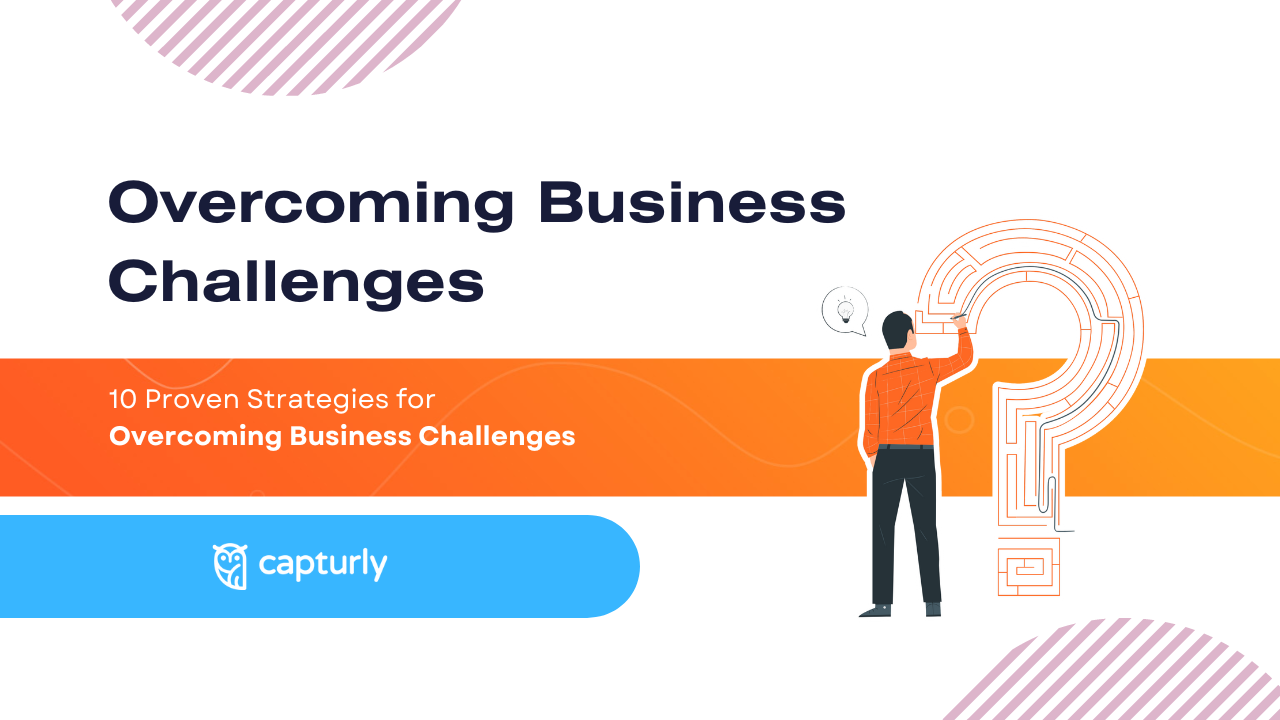


1 Comment
Retro bowl
2024-03-13 at 10:54Please keep writing valuable pieces like this one and then sharing them with the world.